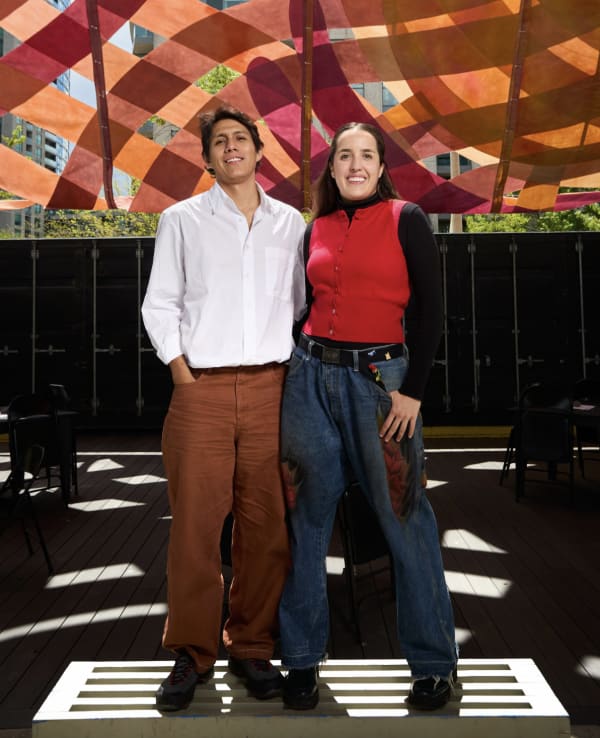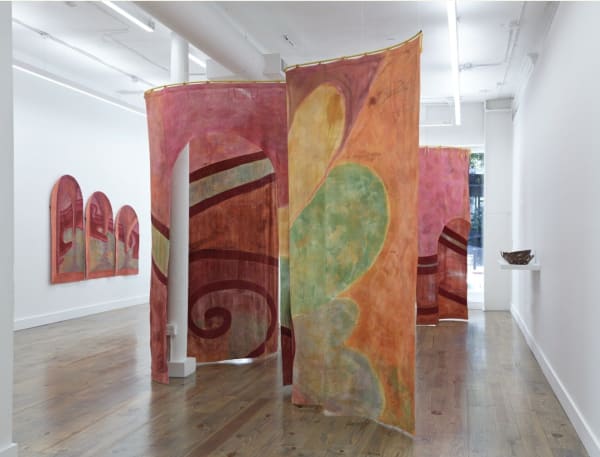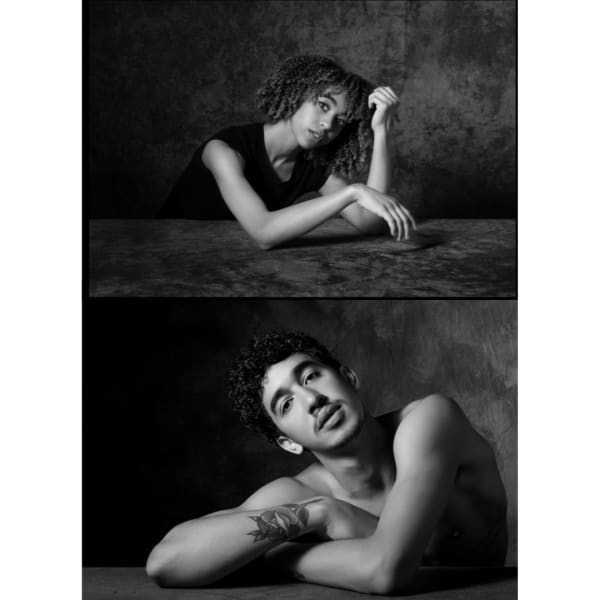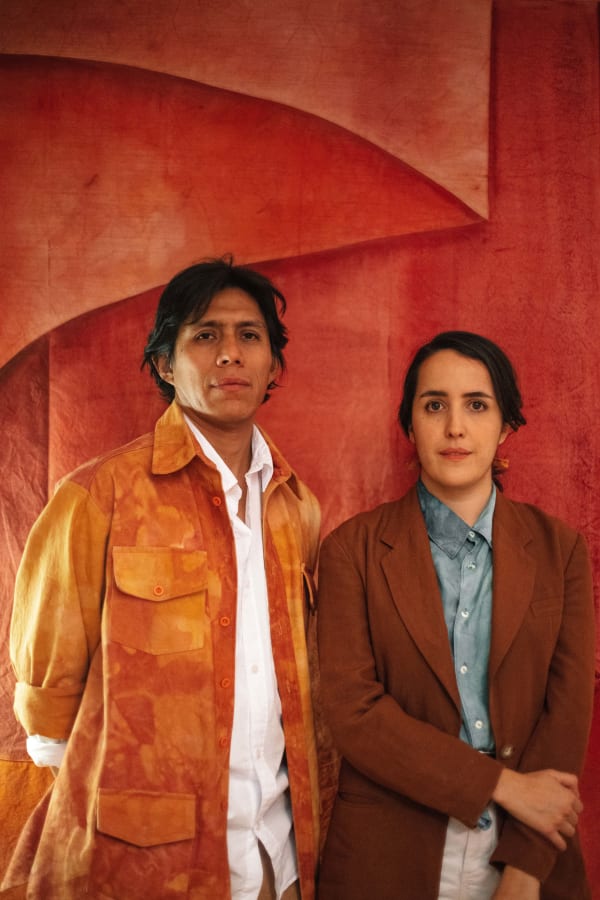Celeste: Hacer brotar / To sprout
Hacer brotar / To sprout is Celeste’s first solo exhibition on the west coast and their debut exhibition with Rebecca Camacho Presents. Celeste is an artist duo based in Mexico City, formed by María Fernanda Camarena (b. Guadalajara, 1988) and Gabriel Rosas Alemán (b. Mexico City, 1983). The artists’ collaborative practice incorporates archetypal images – hands, vessels, spirals, amongst others – that are woven into or painted on large-scale dyed cotton textiles. Their practice comprises discrete sculptural objects as well as multi-part immersive installations. Celeste frequently works in a site-responsive way, responding to the particularities of a site or location, and their presentation at Rebecca Camacho Presents incorporates objects conceived of in relation to the architectural features of the gallery.
The works on view in Hacer brotar / To sprout developed from Celeste’s ongoing research on public art, public spaces, and communities – both contemporary and historical – within Mexico City. Diego Rivera’s El Agua, Origen de la Vida (Water, the Origin of Life) painted in 1951 served as a particularly rich touchstone for the artists. Located in the Chapultepec forest in the Cárcamo de Dolores, El Agua Origen de la Vida intertwines water with the histories of Mexico, visualizing the ways in which water is connected to all – biologically, culturally, spiritually.
Celeste’s installation at Rebecca Camacho Presents draws upon the ideas visualized in Rivera’s mural. Consisting of three separate sections weaving through the gallery’s interior, the arches in Caminos para el agua I, II, and III are based on the form of an aqueduct, an architectural innovation designed to channel water for drinking and irrigation, allowing communities around the world to flourish. Spirals with long linear extensions represent the movement of water, to the life it offers, and bulbous forms suggest the bounty of water that flows along aqueducts and underground within the aquifers below Mexico City. ¡Qué llueva, qué llueva! (Let it rain, Let it rain) is a triptych featuring imagery that resembles cisterns and aqueducts, tools that collect and channel water. The title, “let it rain,” is a direct reference to the environmental changes challenging our relationship to water as well as the aquifers below Mexico City that are in jeopardy because of over extraction and reduced rainfall. These aquifers flow freely without boundaries or borders between Mexico and the United States. Three copper hand-painted vessels titled Anáhuac (surrounded by water), Ollin (movement), Xictli (navel) refer to the inherent traits of water – movement, motion, centrality – in Nahuatl, the language of the Nahua people who have lived in what is now known as Mexico and throughout Central America for thousands of years. Anáhuac is the original Nahua name for Mexico and translates to “land surrounded by water.” Together, the artworks in Hacer brotar / To sprout remind us of the intrinsic and fundamental qualities of water – a vital form of nourishment upon which all life on Earth hinges.
On May 1 at 6:00 pm, Celeste will be in dialogue with Diego Villalobos, Associate Curator, Wattis Institute of Contemporary Art at the California College of the Arts.
-
 Celeste, Caminos para el agua I, 2025
Celeste, Caminos para el agua I, 2025 -
 Celeste, Caminos para el agua II, 2025
Celeste, Caminos para el agua II, 2025 -
 Celeste, Caminos para el agua III, 2025
Celeste, Caminos para el agua III, 2025 -
 Celeste, Anáhuac (surrounded by water), 2025
Celeste, Anáhuac (surrounded by water), 2025 -
 Celeste, Xictli (navel), 2025
Celeste, Xictli (navel), 2025 -
 Celeste, Ollin (movement), 2025
Celeste, Ollin (movement), 2025 -
 Celeste, Water, the origin of life on earth , 2025
Celeste, Water, the origin of life on earth , 2025 -
 Celeste, Untitled, 2025
Celeste, Untitled, 2025 -
 Celeste, ¡Qué llueva, qué llueva! , 2025
Celeste, ¡Qué llueva, qué llueva! , 2025
-

Impulse
Celeste Talks DIY Attitudes and Mexican Hospitality June 7, 2025Mexico City-based artist duo Celeste, Gabriel Rosas Alemán and María Fernanda Camarena, craft fabric-based installations across galleries, museums, and community spaces. The duo recently unveiled...Read more -

Colossal
Celeste’s Immersive Textile Installations Embrace the Warm Intimacy of Home May 9, 2025When María Fernanda Camarena and Gabriel Rosas Alemán aren’t in their Mexico City studio, you might find them pulling weeds or chopping vegetables. “We love...Read more














